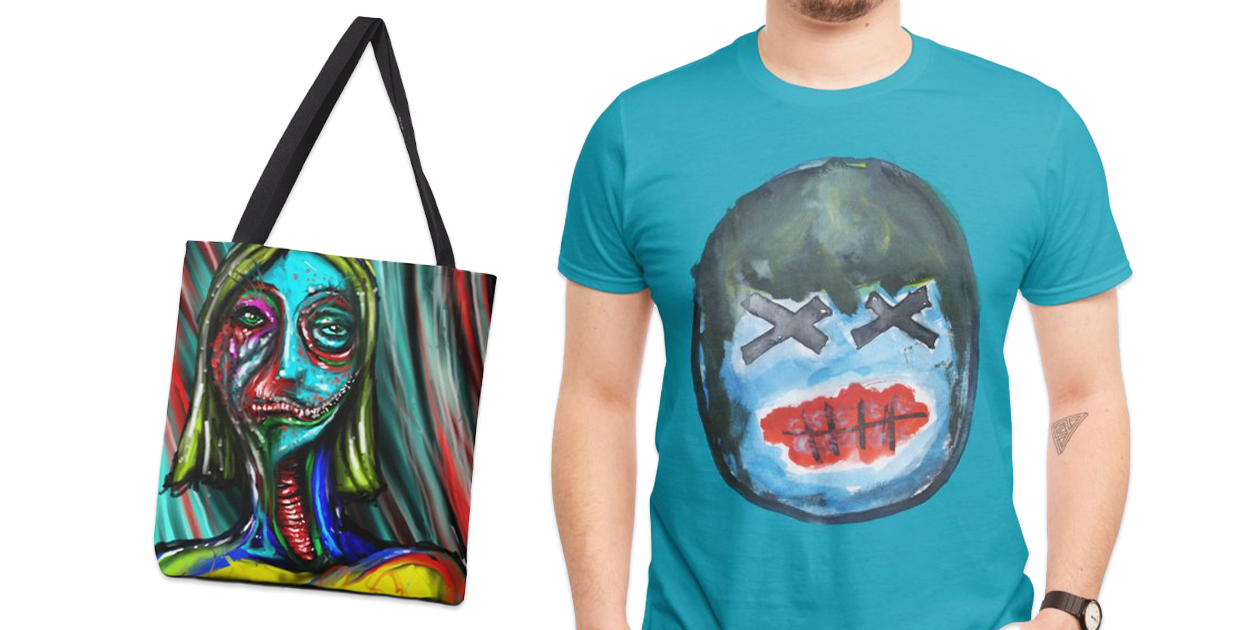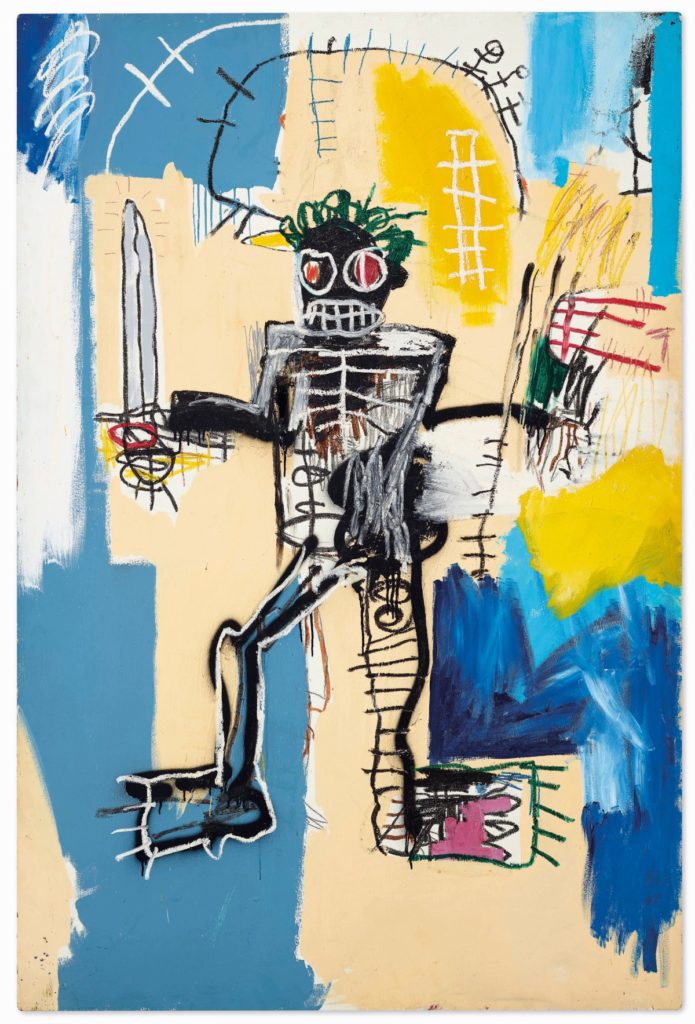The last Art Trends post covered the work of 15th century Renaissance painter Sandro Botticelli. Now, we’re exploring more contemporary art as we dive into one of Jean-Michel Basquiat’s paintings. The late Basquiat is a well-known artist typically associated with Pop artist Andy Warhol. However, despite his close connection with Warhol, Basquiat himself was not a Pop artist. In fact, he was a Neo-Expressionist.
Why are we talking about Basquiat in an Art Trends post in 2021? Well, on March 23rd, Basquiat’s Warrior (1982) is going up for auction. Experts project the painting to sell for $31M–$41M. If the painting sells within or beyond that estimate, it will be the most expensive work by a Western artist auctioned off in Asia. Additionally, it will be one of Basquiat’s top-selling artworks. So, this week, we’re talking about Basquiat’s Warrior, and why this work might be so appealing in today’s art market.
What’s Neo-Expressionism?
Once again, I present to you a brief crash course in the artist’s movement. However, before we dive into things, I have one important note: I will be describing Neo-Expressionism from a U.S. perspective. This clarification is necessary, because the way we view and refer to different art movements is typically informed by our country of origin.
Neo-Expressionism was a reaction to conceptual and minimal art. Neo-Expressionists sought to portray recognizable abstract figures. The “expression” part of the movement’s name comes from the artists’ use of intense and rough brushstrokes. Vivid colors and abstract lines and shapes come together to create works of art that suggest recognizable figures, while still maintaining the symbolism present in abstract art.

Okay, then who’s Jean-Michel Basquiat?
As I’ve stressed in previous Art Trends posts, I won’t get biographical. I’ll always focus on the artist’s work, especially when it comes to marginalized artists. Focusing on the artist’s work is especially important when talking about Basquiat. Art curators, dealers, and auction houses, to this day, do not take his work seriously, which has slowed his climb to global notoriety. Many people still connect him to his social circle and status of a celebrity rather than his work.
We have to recognize that when Basquiat was alive and working, he wasn’t well-known. He had two shows in his lifetime! Also, his first retrospective in the U.K. was in 2017. 2017! Decades after his death, he’s finally receiving accolades. Basquiat also did graffiti work in New York City, an art form looked down upon, due to its racial associations. In fact, some people say Basquiat “elevated” graffiti art. In case you’re not aware, saying an artist “elevated” something is a way of reinforcing the hierarchy of high or fine art and low art. Low art usually means artists who aren’t formally trained and—I’m going to be honest here—artists of color. I could probably write a dissertation on this, but instead I’ll let that marinate and encourage you to explore this phenomenon further.
The Nuances of Basquiat’s Work
Now, let’s discuss Basquiat’s technique. In his work, Basquiat uses vivid colors and intense, rough brushstrokes stylistically common in the movement. Of course, there are ways that his style pushes past the boundaries of the stylistic principles of Neo-Expressionism. Basquiat deviates from the typical Neo-Expressionist style with his inclusion of text—mainly poetry—in his work. Basquiat combines drawing, text, and paint in his unique works.
Additionally, Basquiat’s work reflects cultural heritages as well as a mixture of other cultural histories. He has stated that when he creates art, he thinks about life. Thus, the message of his work could address and challenge social constructs and cultural ideologies.
The Painting in Question

Let’s explore the Basquiat painting that could potentially be the most expensive work of art by a Western artist auctioned in Asia. In Warrior (1982), Basquiat presents us with a Black subject. This person is holding a sword. The lines surrounding the top portion of the blade indicate either shine or divine power. The object in the subject’s other hand is indecipherable. Mostly, the background consists of slashes of vivid blues. However, there are vivid colors throughout the work.
The lines jutting off of the subject’s feet and placed around the figure communicate a prickliness. There are arches in the background, but the centermost arch has stick figures descending it like a hill. You can see how Basquiat mixes drawing and painting as the textures are visibly different throughout the painting.

The main figure has red eyes with slits for pupils and is baring their teeth. Within the body of the main subject is texture. There are lines that indicate the ribcage and other bones. Within the figure there are lines and colors all over the body. Is this meant to communicate war paint? It is possible that Basquiat was drawing on cultural heritage in this work.
The title, Warrior, clues us into what we’re looking at and may hint at the painting’s layered meaning. What if we didn’t know the title? What would we assume? When you first view the painting, your perspective is largely based on social constructs, formed by art canonical representations of Black subjects that are stereotypical and often racist. It is likely that Basquiat acknowledges these perceptions and uses the subject matter to allow the viewer to confront how they perceive Black bodies in art.
Why are We Drawn to This Now?
Could the growing interest in Basquiat’s work speak to his response to the appropriation of cultural imagery in modernist art? While I’m hesitant to describe works of art by marginalized artists as political, we can still acknowledge how in the current state of the world we could read it that way. Art by marginalized artists isn’t inherently political, but we are still able to interpret it as such as a result of our contemporary experiences.
The blending of cultural heritage and how we interact with Basquiat’s abstract imagery could be the reason his work is trending. Think about it—Basquiat could be considered one of the modern “masters.” Yet that’s not his reputation beyond the U.S., and we should unpack why that is. In this moment, once again, curators that have pushed for inclusion in museums and galleries have brought about a shift in their institutional collections. Perhaps the push back on the way the art world has viewed his work and its lack of recognition has influenced the global popularity of his work today. Frankly, the work is both relative to our reaction and feelings in the current political climate, as well as the fight for inclusion in art institutions.



